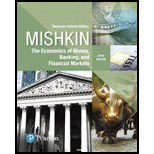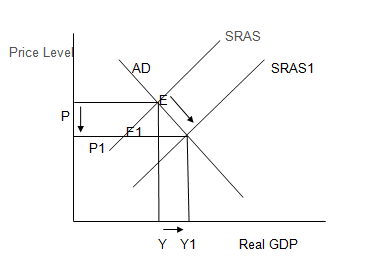
- Change in the inflation rate over the four most recent quarters of data available and the four quarters prior to that
- Changes in the net wages above productivity, the price of oil and inflation expectations over the four most recent quarters of data available and the four quarters prior to that
- The answers to part a and part b using short-run
aggregate supply curves.
Explanation of Solution
Data:
- Personal Consumption Expenditure Price Index - PCE: A measure of Price Level
- Net Wages Above Productivity - NWAP: Compensation − Productivity
- Compensation - Comp: Real Compensation Per Hour
- Productivity- Prod. : Non-Farm Business Sector Real Output Per Hour
- Inflation Expectations - IE: MICH
- Price of Parallel of Oil: PBO
Spreadsheet:
| Year | PCE | Change in Levels of PCE | Change in Inflation Rate % | Comp. | Prod. | NWAP | Change in Level of NWAP | Change in Level of NWAP % | PBO | Change in Level of PBO | Change in Level of PBO % | IE | Change in Level of IE | Change in Level of IE % |
| 2016 Q1 jan | 109.9 | 103.4 | 106.4 | -3 | 31.6 | 2.5 | ||||||||
| 2016 Q2 apr | 110.5 | 103.9 | 106.6 | -2.7 | 40.7 | 2.8 | ||||||||
| 2016 Q3 july | 111 | 104.1 | 107.3 | -3.2 | 44.6 | 2.7 | ||||||||
| 2016 Q4 oct | 111.5 | 102.2 | 107.6 | -5.4 | 49.7 | 2.4 | ||||||||
| 2017 Q1 jan | 112.1 | 2.2 | 2.00 | 102.7 | 107.6 | -4.9 | -1.9 | 63.33 | 52.5 | 20.9 | 66.14 | 2.6 | 0.1 | 4.00 |
| 2017 Q2 apr | 112.2 | 1.7 | 1.54 | 102.8 | 108.1 | -5.3 | -2.6 | 96.30 | 51 | 10.3 | 25.31 | 2.5 | -0.3 | -10.71 |
| 2017 Q3 july | 112.6 | 1.6 | 1.44 | 103.2 | 108.8 | -5.6 | -2.4 | 75.00 | 46.6 | 2 | 4.48 | 2.6 | -0.1 | -3.70 |
| 2017 Q4 oct | 113.4 | 1.9 | 1.70 | 103 | 108.9 | -5.9 | -0.5 | 9.26 | 51.5 | 1.8 | 3.62 | 2.4 | 0 | 0.00 |
*St. Louis Reserve Fred Database
Interpretation: Findings from above Table
- Inflation Rate: Continuously Declining
- Cost of Inputs: Declining
- Labour Productivity: First Increasing and then Declining
- Inflation Expectations: Declining
A fall in oil prices (and a fall in firms costs) will shift the short-run aggregate supply (SRAS) to the right, causing lower inflation and higher real GDP.
The declining inflation expectations meet the declining inflation rate due to a rightward shift in aggregate supply.
If we expect prices to decline in future, the demand for wages declines and so firms reduce their prices. Thus the short term supply [SRAS] would increase.

Introduction:
Aggregate or Total Supply, otherwise called as total yield, is the aggregate supply of products and services delivered inside an economy at a given general price level in a given period. It is depicted by the total supply curve, which indicates the connection between price levels and the amount of yield that organizations will provide. Normally, there is a positive connection between total supply and the price level.
A shift in total supply can be ascribed to various factors. These incorporate changes in the size and nature of work, mechanical developments, technological advancements, an expansion in compensation, an expansion underway costs, changes in producer taxes, subsidies and changes in inflation. A portion of these elements prompts positive changes in total supply while others make total supply decrease.
Want to see more full solutions like this?
Chapter 23 Solutions
Pearson eText Economics of Money, Banking and Financial Markets, The, Business School Edition -- Instant Access (Pearson+)
- 20. Factors 01 pro B. the technological innovations available to companies. A. the laws that regulate manufacturers. C. the resources used to create output D. the waste left over after goods are produced. 21. Table 1.1 shows the tradeoff between different combinations of missile production and home construction, ceteris paribus. Complete the table by calculating the required opportunity costs for both missiles and houses. Then answer the indicated question(s). Combination Number of houses Opportunity cost of houses in Number of missiles terms of missiles J 0 4 K 10,000 3 L 17,000 2 1 M 21,000 0 N 23,000 Opportunity cost of missiles in terms of houses Tutorials-Principles of Economics m health carearrow_forwardIn a small open economy with a floating exchange rate, the supply of real money balances is fixed and a rise in government spending ______ Group of answer choices Raises the interest rate so that net exports must fall to maintain equilibrium in the goods market. Cannot change the interest rate so that net exports must fall to maintain equilibrium in the goods market. Cannot change the interest rate so income must rise to maintain equilibrium in the money market Raises the interest rate, so that income must rise to maintain equilibrium in the money market.arrow_forwardSuppose a country with a fixed exchange rate decides to implement a devaluation of its currency and commits to maintaining the new fixed parity. This implies (A) ______________ in the demand for its goods and a monetary (B) _______________. Group of answer choices (A) expansion ; (B) contraction (A) contraction ; (B) expansion (A) expansion ; (B) expansion (A) contraction ; (B) contractionarrow_forward
- Assume a small open country under fixed exchanges rate and full capital mobility. Prices are fixed in the short run and equilibrium is given initially at point A. An exogenous increase in public spending shifts the IS curve to IS'. Which of the following statements is true? Group of answer choices A new equilibrium is reached at point B. The TR curve will shift down until it passes through point B. A new equilibrium is reached at point C. Point B can only be reached in the absence of capital mobility.arrow_forwardA decrease in money demand causes the real interest rate to _____ and output to _____ in the short run, before prices adjust to restore equilibrium. Group of answer choices rise; rise fall; fall fall; rise rise; fallarrow_forwardIf a country's policy makers were to continously use expansionary monetary policy in an attempt to hold unemployment below the natural rate , the long urn result would be? Group of answer choices a decrease in the unemployment rate an increase in the level of output All of these an increase in the rate of inflationarrow_forward
- A shift in the Aggregate Supply curve to the right will result in a move to a point that is southwest of where the economy is currently at. Group of answer choices True Falsearrow_forwardAn oil shock can cause stagflation, a period of higher inflation and higher unemployment. When this happens, the economy moves to a point to the northeast of where it currently is. After the economy has moved to the northeast, the Federal Reserve can reduce that inflation without having to worry about causing more unemployment. Group of answer choices True Falsearrow_forwardThe long-run Phillips Curve is vertical which indicates Group of answer choices that in the long-run, there is no tradeoff between inflation and unemployment. that in the long-run, there is no tradeoff between inflation and the price level. None of these that in the long-run, the economy returns to a 4 percent level of inflation.arrow_forward
- Suppose the exchange rate between the British pound and the U.S. dollar is £1 = $2.00. The U.S. government implementsU.S. government implements a contractionary fiscal policya contractionary fiscal policy. Illustrate the impact of this change in the market for pounds. 1.) Using the line drawing tool, draw and label a new demand line. 2.) Using the line drawing tool, draw and label a new supply line. Note: Carefully follow the instructions above and only draw the required objects.arrow_forwardJust Part D please, this is for environmental economicsarrow_forward3. Consider a single firm that manufactures chemicals and generates pollution through its emissions E. Researchers have estimated the MDF and MAC curves for the emissions to be the following: MDF = 4E and MAC = 125 – E Policymakers have decided to implement an emissions tax to control pollution. They are aware that a constant per-unit tax of $100 is an efficient policy. Yet they are also aware that this policy is not politically feasible because of the large tax burden it places on the firm. As a result, policymakers propose a two- part tax: a per unit tax of $75 for the first 15 units of emissions an increase in the per unit tax to $100 for all further units of emissions With an emissions tax, what is the general condition that determines how much pollution the regulated party will emit? What is the efficient level of emissions given the above MDF and MAC curves? What are the firm's total tax payments under the constant $100 per-unit tax? What is the firm's total cost of compliance…arrow_forward

 Principles of Economics (12th Edition)EconomicsISBN:9780134078779Author:Karl E. Case, Ray C. Fair, Sharon E. OsterPublisher:PEARSON
Principles of Economics (12th Edition)EconomicsISBN:9780134078779Author:Karl E. Case, Ray C. Fair, Sharon E. OsterPublisher:PEARSON Engineering Economy (17th Edition)EconomicsISBN:9780134870069Author:William G. Sullivan, Elin M. Wicks, C. Patrick KoellingPublisher:PEARSON
Engineering Economy (17th Edition)EconomicsISBN:9780134870069Author:William G. Sullivan, Elin M. Wicks, C. Patrick KoellingPublisher:PEARSON Principles of Economics (MindTap Course List)EconomicsISBN:9781305585126Author:N. Gregory MankiwPublisher:Cengage Learning
Principles of Economics (MindTap Course List)EconomicsISBN:9781305585126Author:N. Gregory MankiwPublisher:Cengage Learning Managerial Economics: A Problem Solving ApproachEconomicsISBN:9781337106665Author:Luke M. Froeb, Brian T. McCann, Michael R. Ward, Mike ShorPublisher:Cengage Learning
Managerial Economics: A Problem Solving ApproachEconomicsISBN:9781337106665Author:Luke M. Froeb, Brian T. McCann, Michael R. Ward, Mike ShorPublisher:Cengage Learning Managerial Economics & Business Strategy (Mcgraw-...EconomicsISBN:9781259290619Author:Michael Baye, Jeff PrincePublisher:McGraw-Hill Education
Managerial Economics & Business Strategy (Mcgraw-...EconomicsISBN:9781259290619Author:Michael Baye, Jeff PrincePublisher:McGraw-Hill Education





